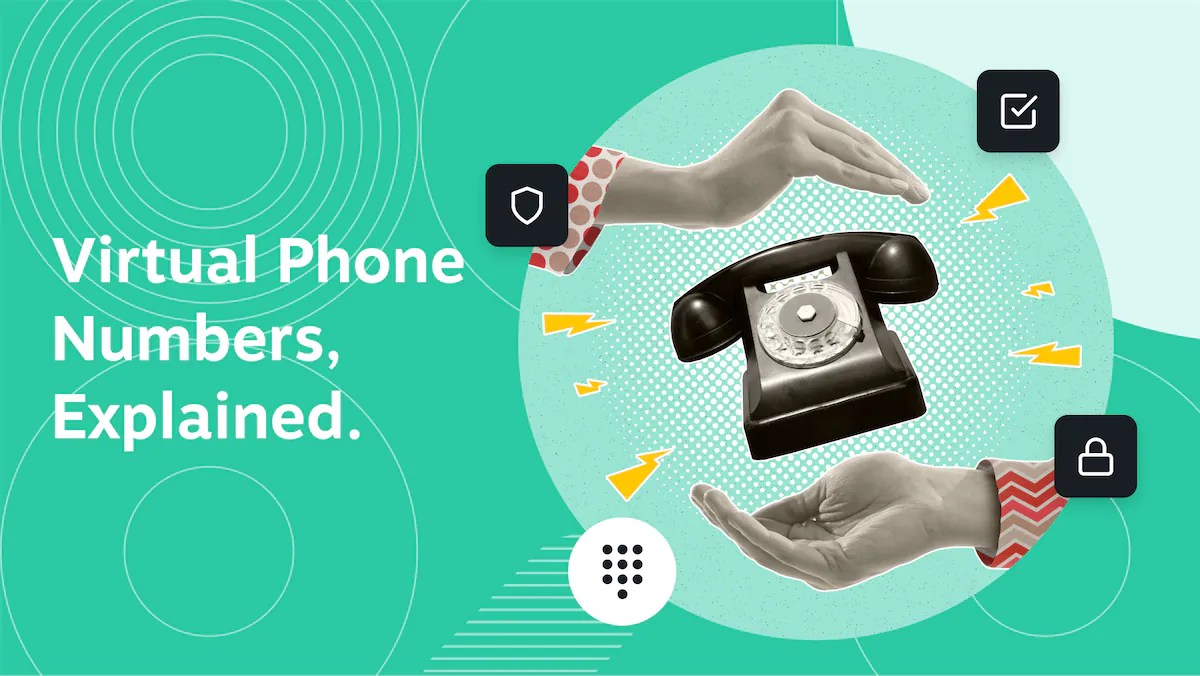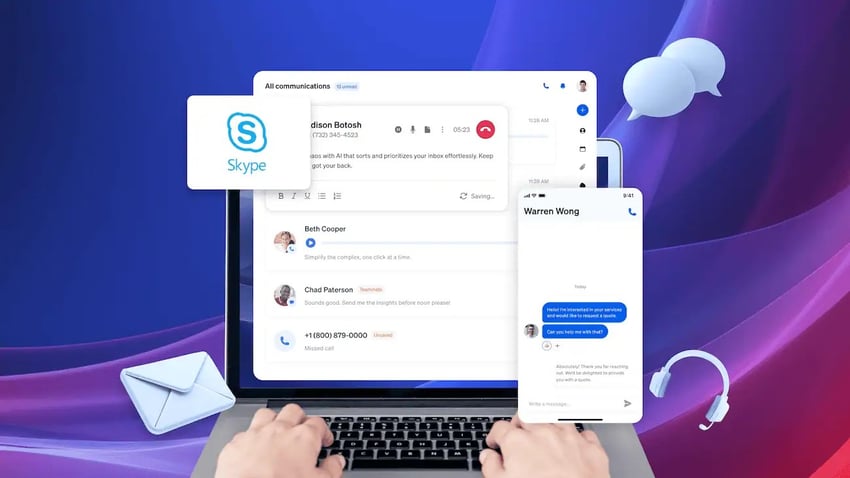If your phone system constantly sends customers to voicemail or keeps your team tied to a desk, it’s not only frustrating but also bad for business. Outdated phone systems slow response times, confuse, and make your business appear less professional. They also lead to missed calls and lost business.
That’s where virtual phone numbers come in, offering you a flexible, upgraded virtual phone system that works from anywhere, without additional hardware or complex setup.
Let’s learn what a virtual phone number is, how it works, and how to quickly set one up.
What Is a Virtual Phone Number?
A virtual phone number is a cloud-based business phone number that isn’t tied to a physical phone line or SIM card and allows you to make and receive calls over an internet connection from anywhere in the world. Its flexibility and advanced features far surpass those of traditional phone lines.
With a virtual number, you can separate business and personal calls, establish a local presence in different regions, or set up a toll-free number for customer service. It’s a versatile tool that adapts to the needs of businesses of all sizes — from solopreneurs to large enterprises.

How Do Virtual Phone Numbers Work?
Virtual phone numbers work via Voice over Internet Protocol (VoIP). This is the same technology behind services like WhatsApp (for Android), iMessage (for iOS), and Google Voice. Instead of using landlines or SIM cards, VoIP transmits calls over an internet connection (Wi-Fi, LTE, or 5G).
Here’s how a virtual phone number works:
- A call is placed to your virtual phone number.
- The call is routed through your VoIP provider’s cloud-based servers.
- The provider then forwards the call to one or more devices you select, such as a desk phone, a mobile phone, or a computer running softphone software.
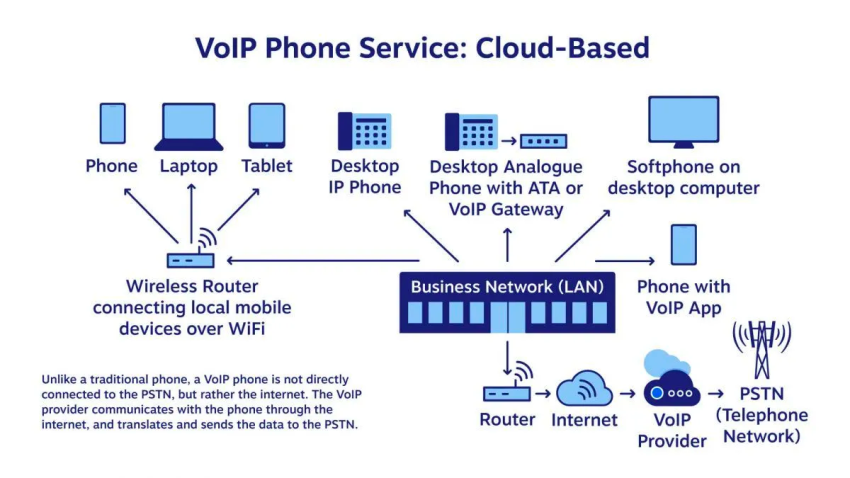
This process is flexible and customizable. You can configure call routing according to your business hours, caller ID, or call volume. For example, calls can ring on your office system during business hours. After business hours, you can automatically forward calls to a mobile number or voicemail.
Virtual numbers have three key uses:
- Acts as a dedicated executive line.
- Forwards calls to another business phone number.
- Works with an auto-attendant to greet callers and provide a menu of options.
In short, with virtual numbers, you control how, when, and where you receive calls without having a physical telephone infrastructure.
Types of Virtual Phone Numbers
Virtual phone numbers come in a variety of configurations, each tailored to different business needs. Let’s take a look at some of the most common types:
- Local phone numbers: Telephone numbers located in specific geographic areas, also called rate centers or local area codes.
- Toll-free numbers: Special numbers beginning with 800, 888, 866, and others, allowing customers to call without incurring fees.
- International numbers: For global companies, international business numbers help make and receive international calls while maintaining a local presence in the country.
- Vanity numbers: Memorable and easy to remember, such as 1-800-FLOWERS. You have to purchase and port these numbers.
💡 Remember: You can keep your current phone number and transfer it to a virtual phone system. As your business expands, you can always select new numbers or swap existing ones.
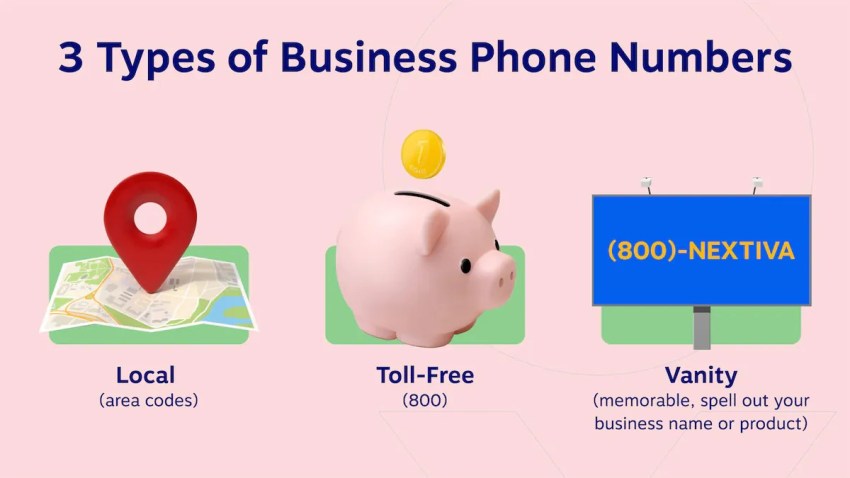
10 Key Benefits of Using a Virtual Phone Number
Since a virtual business phone number isn’t tied to a physical location, you can access it from any internet-enabled device. But its flexibility isn’t its only advantage. Here are some of the key benefits of using a virtual phone number.
1. Work from anywhere
Virtual phone numbers allow you to answer calls from mobile apps, tablets, computer apps, or VoIP-enabled desk phones with a consistent business identity. Employees can work remotely, travel freely, and collaborate from different locations without disrupting customer communications. This creates a consistent, professional presence, no matter where your team works.
2. Separate business and personal calls
With a virtual phone number, you no longer have to combine personal and business calls on one device. You can set up a separate business number to keep track of everything and protect your privacy.
Customers only see your business number when they call, keeping your personal contact information confidential. This is best for freelancers, remote workers, and small business owners who use their personal phone for work.

3. Create a professional presence
Your business number may be the first point of contact customers have. Using a local or toll-free number makes you more credible and accessible. Local numbers create familiarity with local customers, while toll-free numbers convey national credibility. Add personalized greetings, call menus, and business hours settings to build a professional and consistent experience for every caller.
4. Improve customer satisfaction
An auto attendant automatically answers calls, provides a professional greeting, and transfers them to the appropriate contact. This eliminates long wait times and ensures questions are answered competently, especially after business hours. Auto attendants enable even small teams to provide an optimal customer experience without the need for additional staff.
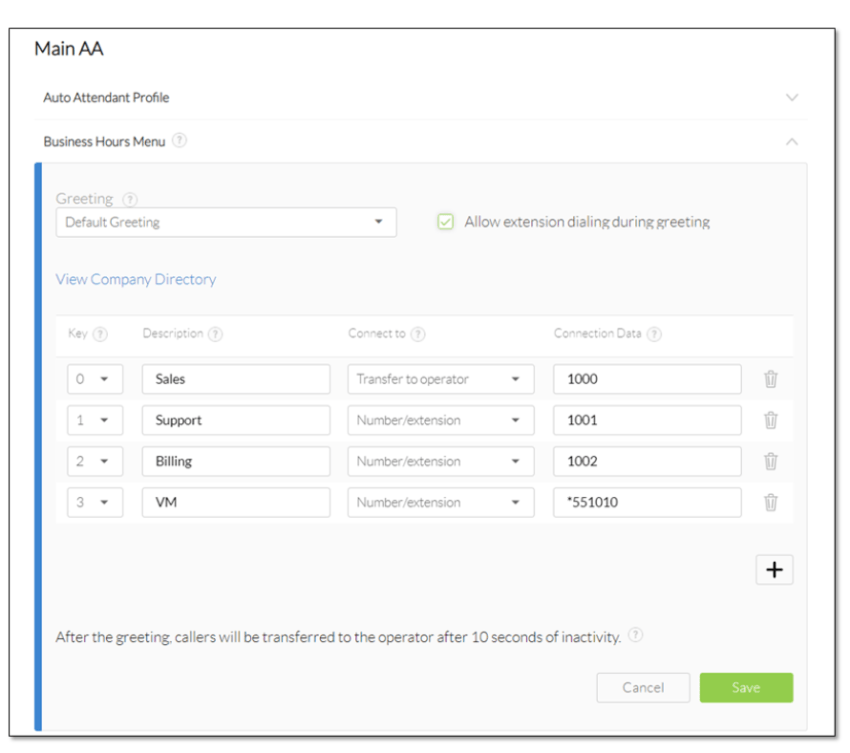
5. Never miss a call
With advanced call forwarding, you can route incoming calls to multiple devices or team members based on rules. Calls can be forwarded to specific times, transferred to available agents, or rotated between departments. This reduces the likelihood of customers reaching voicemail or being on hold for too long. Every call is handled promptly and professionally.
6. Modernize your voicemail
Traditional voicemail systems are outdated and difficult to manage. Virtual phone systems can automatically transcribe voicemail messages and send them via email or SMS. This feature lets you review and respond to voicemail messages more quickly, in a meeting or on the go. You stay informed and respond quickly without having to dial into a voicemail message.
7. Cut costs on hardware and international calls
Because virtual numbers use the internet to make and receive calls, you don’t need expensive hardware or a complex phone system. You can make outbound calls using a cell phone or computer, keeping upfront costs low.
Landline phone systems or expensive international calling plans aren’t required. Competitive VoIP rates make global customer service cost-effective and quite accessible for small businesses looking to expand their reach without increasing overhead.
8. Track your marketing performance
By assigning different virtual numbers to individual marketing campaigns, you can better understand what’s working. You can measure how many phone calls result from each campaign — whether it’s a social media ad, a billboard, or an email newsletter.
These insights help you adjust your strategy and maximize the return on your marketing spend. Data informs your decision-making, enables smarter budgeting, and helps you optimize your reach for maximum ROI.
9. Scale your business with ease
As your team grows, a virtual phone system makes it easy to add new phone lines or departments. You don’t need technical support or additional hardware to get started. New numbers can be added and configured directly through a user-friendly dashboard. Virtual phone numbers are a practical option for growing businesses that need to remain flexible.
10. Offer secure and reliable communications
Free virtual numbers are often classified as unreliable or insecure by authentication platforms. Professional providers, on the other hand, offer secure, dedicated numbers that aren’t reused or shared. Your communications are encrypted and managed on secure servers, protecting sensitive business data. This security and reliability build trust with customers and protect your reputation.
How To Get a Virtual Phone Number in 3 Simple Steps
How do you get started with a virtual phone number? These three simple steps are all you need to set up a virtual phone number.
Step 1: Choose your provider and plan
Choose a VoIP provider that fits your business needs. Look for features like call forwarding, call transfer, auto attendant, voicemail-to-email, and good customer service.
A good provider should offer flexible plans that scale with your business. Compare prices, features, and customer reviews, and look for excellent call quality and customer support. Picking the right platform from the start will save time and hassle later.

Step 2: Select your virtual number
When signing up, you’ll need to select your virtual phone number. You can choose a local number for your local community, a toll-free number for a larger audience, or a vanity number to support your brand. Some providers also offer international options for global customers.
Getting the right business phone number better showcases your business as more established and accessible. Your virtual number should match your brand profile.
Step 3: Set up and customize your phone system
Once you get your number, you can personalize call management and set up call flows. Route calls to mobile phones, desktop PCs, or VoIP phones, and add customized greetings, call menus, and business hours that fit your workflows to create a positive customer experience. You don’t need any technical knowledge to set up virtual phone numbers with helpful providers like Nextiva, who will guide you through the process and provide support at any time.
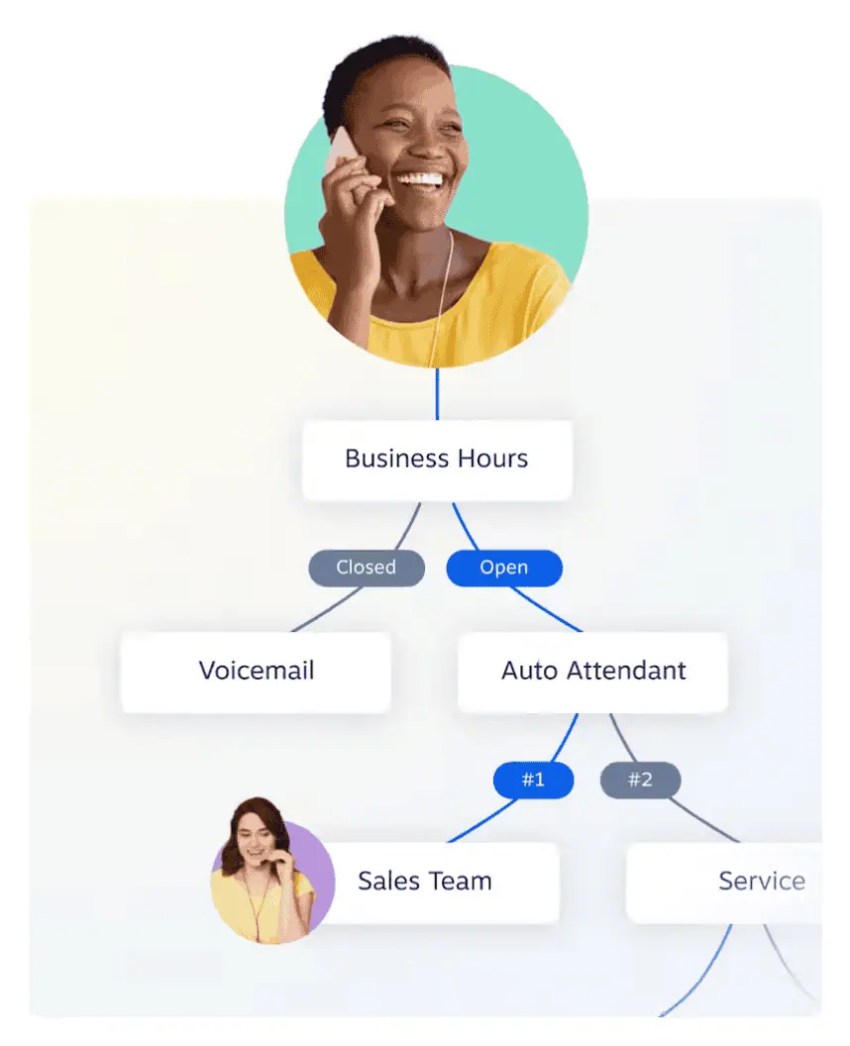
Start calling for just $15/mo.
See why over 100,000 businesses switched to Nextiva. Now you can get it all for $15/month per user.
Differences Between Virtual & Regular Phone Numbers
Why should you switch from a traditional to a virtual phone number in the first place? Let’s look at the key differences that will make the switch easier.
| Traditional phone numbers | Virtual phone numbers |
|---|---|
| Provided and installed by local telephone companies | Operate over the internet using Voice over IP |
| Tied to a physical location or street address | Location-independent; not tied to any physical location |
| Require physical phone lines to be installed throughout the office | No physical lines needed as calls are routed through a cloud-based system |
| Calls can only be answered where the line is installed | Calls can be answered on any device: desk phone, mobile phone, or computer |
| Difficult and costly to install in non-traditional workspaces | Easily accessible for in-office, remote, or hybrid teams |
| Caller ID reveals office or personal numbers | Protects user privacy and displays the business number only |
| Limited flexibility in routing and scheduling calls | Customizable call routing, forwarding, and availability settings |
| Usually, one line per device or extension | Multiple users can share the same number and receive calls simultaneously |
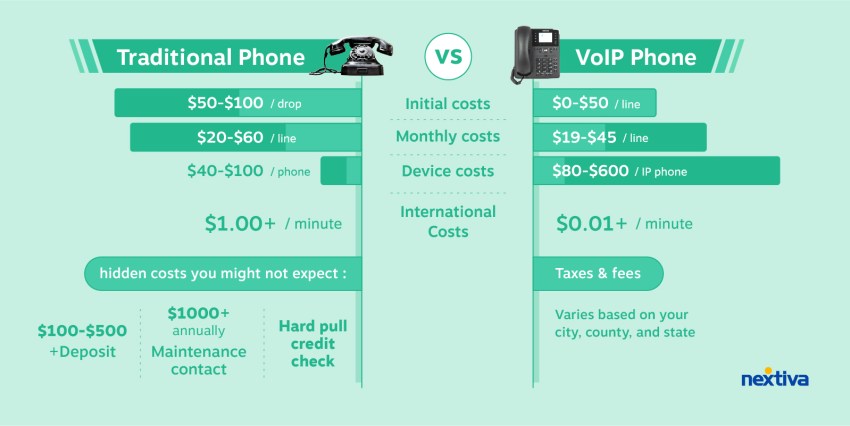
Limitations of Free Virtual Phone Numbers
Free virtual phone number providers can be attractive for startups or general use. However, they’re limited and can impact your company’s credibility and performance.
- Limited functionality: Free options offer only basic calling and texting capabilities. Important business features, like unlimited calling, call recording, voicemail transcription, IVR menus, or call forwarding, are unavailable or require a fee.
- Security issues: Free numbers are often recycled and can be flagged as spam. Because you don’t really own the number, you risk losing it without notice. They’re also frequently considered untrusted by two-factor authentication (2FA) platforms.
- Device limitations: Most free apps are for mobile devices and don’t work on desktops or laptops, limiting the flexibility of remote teams.
- Interruptions and ads: Be prepared for intrusive ads, call limits, and poor call quality during peak hours.
A cloud-based VoIP provider like Nextiva addresses the biggest problems with free virtual phone services. It offers secure, dedicated numbers, sophisticated features like auto attendant and call forwarding, and the flexibility to make calls from any device without ads or service restrictions.
With scalable plans, reliable performance, and flat rates, you can add users or numbers at any time. You get a flexible, professional phone system that supports both your customers and your team.
Power Your Business With a Nextiva Virtual Phone Number
Virtual phone numbers give businesses the flexibility, professionalism, and cost savings they need to continue growing and stand out from the crowd. Whether you’re managing a remote team, expanding into new markets, or simply looking to enhance your brand image, a virtual number optimizes communications and improves your customer experience.
But choosing the right provider is key.
With Nextiva, setting up a virtual phone number is just the beginning. You get access to a complete, cloud phone service trusted by over 100K+ businesses. Our VoIP system is easy to set up, scalable, and offers powerful features like auto attendant, advanced call forwarding, and voicemail-to-email — all at one affordable rate.
Don’t let an outdated phone system hold you back. Partner with a secure and reliable leader in business communications.

Start calling for just $15/mo.
See why over 100,000 businesses switched to Nextiva. Now you can get it all for $15/month per user.
Virtual Phone Number FAQs
You can port your existing local or toll-free number to a new virtual provider through number porting. A reliable provider like Nextiva will handle the entire porting process for you, keeping your business communications running smoothly. You get to enjoy all the benefits of a virtual phone system without changing your phone number.
You don’t need any special hardware, and can use your virtual number to make and receive calls on your existing devices, including:
Mobile phones (via mobile apps)
Computers and laptops (via a softphone app)
Existing VoIP desk phones
With virtual phone numbers, your team stays connected at their desk or on the go without requiring large investments in new devices.
Yes, most professional virtual phone numbers support business text messaging, SMS, and multimedia messaging (MMS). With a business VoIP service like Nextiva, you can send and receive SMS messages directly from your business number using a dedicated desktop or mobile app. You can easily separate your personal and business messages, manage all conversations on a central platform, and maintain a professional image when communicating with clients.
While free services are ideal for personal use, a professional business VoIP service provider like Nextiva offers a unified communications platform designed for growth. Key differences include guaranteed reliability and availability (SLA), advanced features like a multilevel auto attendant, call recording, detailed analytics, and dedicated customer support. Business platforms are also scalable and let you easily add users, lines, and locations as you grow.
Yes, when sourced from a reputable business provider like Nextiva, virtual phone numbers are highly secure. Communications are encrypted, and the numbers are dedicated to your account, not recycled. Always choose a trusted service provider and follow best practices for password security.
For personal use, services like Google Voice or TextNow offer basic numbers for free, though they may include ads and have limitations.
For business purposes, a dedicated virtual phone number is included with a paid subscription from a provider like Nextiva. While the service has a monthly fee for advanced features, reliability, and security, there’s no separate or additional charge for the virtual phone number itself.
Virtual phone numbers give employees access to the office phone system from anywhere with an internet connection. Your team can make and receive calls using their business number, either via a computer or mobile app, and maintain a professional presence even when away from the office. Virtual numbers unite a distributed workforce under a unified business phone system.

















 VoIP
VoIP 
